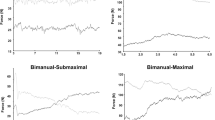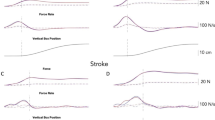Abstract
Dynamic force modulation is critical for performing skilled bimanual tasks. Unilateral motor impairments after stroke contribute to asymmetric hand function. Here, we investigate the impact of stroke on dynamic bimanual force control and compare the contribution of each hand to a bimanual task. Thirteen chronic stroke and thirteen healthy control participants performed bimanual, isometric finger flexion during visually guided, force tracking of a trapezoidal trajectory with force increment and decrement phases. We quantified the accuracy and variability of total force from both hands. Individual hand contribution was quantified with the proportion of force contributed to total force and force variability of each hand. The total force output was 53.10% less accurate and 56% more variable in the stroke compared with the control group. The variability of total force was 91.10% greater in force decrement than increment phase. In stroke group, the proportion of force and force variability contributed by each hand differed across the two phases. During force decrement, the proportion of force contributed by the non-paretic hand reduced and force variability of the non-paretic hand increased, compared with the increment phase. The control group showed no differences in each hand’s contribution across the two force phases. In conclusion, dynamic bimanual force modulation is impaired after stroke, with greater deficits in force decrement than force increment. The non-paretic and paretic hands adapt differentially to dynamic bimanual task constraints. During force decrement, the non-paretic hand preferentially assumes force modulation, while the paretic hand produces steady force to meet the force requirements.




Similar content being viewed by others
References
Allgower K, Hermsdorfer J (2017) Fine motor skills predict performance in the Jebsen Taylor Hand Function Test after stroke. Clin Neurophysiol 128:1858–1871. https://doi.org/10.1016/j.clinph.2017.07.408
Archer DB, Misra G, Patten C, Coombes SA (2016) Microstructural properties of premotor pathways predict visuomotor performance in chronic stroke. Hum Brain Mapp 37:2039–2054. https://doi.org/10.1002/hbm.23155
Archer DB, Kang N, Misra G, Marble S, Patten C, Coombes SA (2018) Visual feedback alters force control and functional activity in the visuomotor network after stroke. NeuroImage Clin 17:505–517. https://doi.org/10.1016/j.nicl.2017.11.012
Basilio ML, de Faria-Fortini I, Polese JC, Scianni AA, Faria CD, Teixeira-Salmela LF (2016) Handgrip strength deficits best explain limitations in performing bimanual activities after stroke. J Phys Ther Sci 28:1161–1165. https://doi.org/10.1589/jpts.28.1161
Bertrand AM, Mercier C, Shun PL, Bourbonnais D, Desrosiers J (2004) Effects of weakness on symmetrical bilateral grip force exertion in subjects with hemiparesis. J Neurophysiol 91:1579–1585. https://doi.org/10.1152/jn.00597.2003
Bertrand AM, Fournier K, Wick Brasey MG, Kaiser ML, Frischknecht R, Diserens K (2015) Reliability of maximal grip strength measurements and grip strength recovery following a stroke. J Hand Ther 28:356–362. https://doi.org/10.1016/j.jht.2015.04.004 (quiz 363)
Blennerhassett JM, Carey LM, Matyas TA (2006) Grip force regulation during pinch grip lifts under somatosensory guidance: comparison between people with stroke and healthy controls. Arch Phys Med Rehabil 87:418–429. https://doi.org/10.1016/j.apmr.2005.11.018
Blennerhassett JM, Carey LM, Matyas TA (2008) Clinical measures of handgrip limitation relate to impaired pinch grip force control after stroke. J Hand Ther 21:245–252. https://doi.org/10.1197/j.jht.2007.10.021 (quiz 253)
Bohannon RW, Smith MB (1987) Interrater reliability of a modified Ashworth scale of muscle spasticity. Phys Ther 67:206–207
Bonan IV, Colle FM, Guichard JP, Vicaut E, Eisenfisz M, Tran Ba Huy P, Yelnik AP (2004) Reliance on visual information after stroke. Part I: balance on dynamic posturography. Arch Phys Med Rehabil 85:268–273
Chow JW, Stokic DS (2011) Force control of quadriceps muscle is bilaterally impaired in subacute stroke. J Appl Physiol (1985) 111:1290–1295. https://doi.org/10.1152/japplphysiol.00462.2011
Christou EA (2011) Aging and variability of voluntary contractions. Exerc Sport Sci Rev 39:77–84. https://doi.org/10.1097/JES.0b013e31820b85ab
Cruz EG, Waldinger HC, Kamper DG (2005) Kinetic and kinematic workspaces of the index finger following stroke. Brain 128:1112–1121. https://doi.org/10.1093/brain/awh432
Dispa D, Thonnard JL, Bleyenheuft Y (2014) Impaired predictive and reactive control of precision grip in chronic stroke patients. Int J Rehabil Res 37:130–137. https://doi.org/10.1097/mrr.0000000000000045
Fugl-Meyer AR, Jaasko L, Leyman I, Olsson S, Steglind S (1975) The post-stroke hemiplegic patient. 1. a method for evaluation of physical performance. Scand J Rehabil Med 7:13–31
Gebruers N, Vanroy C, Truijen S, Engelborghs S, De Deyn PP (2010) Monitoring of physical activity after stroke: a systematic review of accelerometry-based measures. Arch Phys Med Rehabil 91:288–297. https://doi.org/10.1016/j.apmr.2009.10.025
Gorniak SL, Alberts JL (2013) Effects of task complexity on grip-to-load coordination in bimanual actions. Exp Brain Res 225:559–567. https://doi.org/10.1007/s00221-012-3395-y
Gorniak SL, Zatsiorsky VM, Latash ML (2010) Manipulation of a fragile object. Exp Brain Res 202:413–430. https://doi.org/10.1007/s00221-009-2148-z
Grichting B, Hediger V, Kaluzny P, Wiesendanger M (2000) Impaired proactive and reactive grip force control in chronic hemiparetic patients. Clin Neurophysiol 111:1661–1671
Hatem SM, Saussez G, Della Faille M, Prist V, Zhang X, Dispa D, Bleyenheuft Y (2016) Rehabilitation of motor function after stroke: a multiple systematic review focused on techniques to stimulate upper extremity recovery. Front Hum Neurosci 10:442. https://doi.org/10.3389/fnhum.2016.00442
Hermsdorfer J, Hagl E, Nowak DA, Marquardt C (2003) Grip force control during object manipulation in cerebral stroke. Clin Neurophysiol 114:915–929
Hu X, Suresh AK, Rymer WZ, Suresh NL (2015) Assessing altered motor unit recruitment patterns in paretic muscles of stroke survivors using surface electromyography. J Neural Eng 12:066001. https://doi.org/10.1088/1741-2560/12/6/066001
Johansson RS (2002) Dynamic use of tactile afferent signals in control of dexterous manipulation. Adv Exp Med Biol 508:397–410
Jorgensen HS, Nakayama H, Raaschou HO, Vive-Larsen J, Stoier M, Olsen TS (1995) Outcome and time course of recovery in stroke. Part I: outcome. The Copenhagen Stroke Study. Arch Phys Med Rehabil 76:399–405
Kamper DG, Harvey RL, Suresh S, Rymer WZ (2003) Relative contributions of neural mechanisms versus muscle mechanics in promoting finger extension deficits following stroke. Muscle Nerve 28:309–318. https://doi.org/10.1002/mus.10443
Kang N, Cauraugh JH (2014) Bimanual force variability and chronic stroke: asymmetrical hand control. PLoS One 9:e101817. https://doi.org/10.1371/journal.pone.0101817
Kang N, Cauraugh JH (2015) Bimanual force variability in chronic stroke: with and without visual information. Neurosci Lett 587:41–45. https://doi.org/10.1016/j.neulet.2014.12.028
Kurillo G, Zupan A, Bajd T (2004) Force tracking system for the assessment of grip force control in patients with neuromuscular diseases. Clin Biomech (Bristol, Avon) 19:1014–1021. https://doi.org/10.1016/j.clinbiomech.2004.07.003
Li S (2013) Analysis of increasing and decreasing isometric finger force generation and the possible role of the corticospinal system in this process. Mot Control 17:221–237
Lindberg P, Ody C, Feydy A, Maier MA (2009) Precision in isometric precision grip force is reduced in middle-aged adults. Exp Brain Res 193:213–224. https://doi.org/10.1007/s00221-008-1613-4
Lodha N, Christou EA (2017) Low-frequency oscillations and control of the motor output. Front Physiol 8:78. https://doi.org/10.3389/fphys.2017.00078
Lodha N, Naik SK, Coombes SA, Cauraugh JH (2010) Force control and degree of motor impairments in chronic stroke. Clin Neurophysiol 121:1952–1961. https://doi.org/10.1016/j.clinph.2010.04.005
Lodha N, Coombes SA, Cauraugh JH (2012a) Bimanual isometric force control: asymmetry and coordination evidence post stroke. Clin Neurophysiol 123:787–795. https://doi.org/10.1016/j.clinph.2011.08.014
Lodha N, Patten C, Coombes SA, Cauraugh JH (2012b) Bimanual force control strategies in chronic stroke: finger extension versus power grip. Neuropsychologia 50:2536–2545. https://doi.org/10.1016/j.neuropsychologia.2012.06.025
Michielsen ME, Selles RW, Stam HJ, Ribbers GM, Bussmann JB (2012) Quantifying nonuse in chronic stroke patients: a study into paretic, nonparetic, and bimanual upper-limb use in daily life. Arch Phys Med Rehabil 93:1975–1981. https://doi.org/10.1016/j.apmr.2012.03.016
Morrison S, Newell KM (1998) Interlimb coordination as a function of isometric force output. J Mot Behav 30:323–342. https://doi.org/10.1080/00222899809601347
Mottram CJ, Heckman CJ, Powers RK, Rymer WZ, Suresh NL (2014) Disturbances of motor unit rate modulation are prevalent in muscles of spastic-paretic stroke survivors. J Neurophysiol 111:2017–2028. https://doi.org/10.1152/jn.00389.2013
Naik SK, Patten C, Lodha N, Coombes SA, Cauraugh JH (2011) Force control deficits in chronic stroke: grip formation and release phases. Exp Brain Res 211:1–15. https://doi.org/10.1007/s00221-011-2637-8
Nasreddine ZS et al (2005) The Montreal Cognitive Assessment, MoCA: a brief screening tool for mild cognitive impairment. J Am Geriatr Soc 53:695–699. https://doi.org/10.1111/j.1532-5415.2005.53221.x
Newell KM, Broderick MP, Deutsch KM, Slifkin AB (2003) Task goals and change in dynamical degrees of freedom with motor learning. J Exp Psychol Hum Percept Perform 29:379–387
Ohtaka C, Fujiwara M (2016) Control strategies for accurate force generation and relaxation. Percept Mot Skills 123:489–507. https://doi.org/10.1177/0031512516664778
Oldfield RC (1971) The assessment and analysis of handedness: the Edinburgh inventory. Neuropsychologia 9:97–113
Park SH, Kwon M, Solis D, Lodha N, Christou EA (2016) Motor control differs for increasing and releasing force. J Neurophysiol 115:2924–2930. https://doi.org/10.1152/jn.00715.2015
Rose DK, Winstein CJ (2004) Bimanual training after stroke: are two hands better than one? Top Stroke Rehabil 11:20–30. https://doi.org/10.1310/ncb1-jwaa-09qe-7txb
Seo NJ, Rymer WZ, Kamper DG (2009) Delays in grip initiation and termination in persons with stroke: effects of arm support and active muscle stretch exercise. J Neurophysiol 101:3108–3115. https://doi.org/10.1152/jn.91108.2008
Sosnoff JJ, Voudrie SJ (2009) Practice and age-related loss of adaptability in sensorimotor performance. J Mot Behav 41:137–146. https://doi.org/10.3200/jmbr.41.2.137-146
Stein J, Krebs HI, Frontera WR, Fasoli SE, Hughes R, Hogan N (2004) Comparison of two techniques of robot-aided upper limb exercise training after stroke. Am J Phys Med Rehabil 83:720–728
Vaillancourt DE, Slifkin AB, Newell KM (2002) Inter-digit individuation and force variability in the precision grip of young, elderly, and Parkinson’s disease participants. Mot Control 6:113–128
van Delden AL, Peper CL, Nienhuys KN, Zijp NI, Beek PJ, Kwakkel G (2013) Unilateral versus bilateral upper limb training after stroke: the Upper Limb Training After Stroke clinical trial. Stroke 44:2613–2616. https://doi.org/10.1161/strokeaha.113.001969
Voelcker-Rehage C, Alberts JL (2005) Age-related changes in grasping force modulation. Exp Brain Res 166:61–70. https://doi.org/10.1007/s00221-005-2342-6
Waddell KJ, Strube MJ, Bailey RR, Klaesner JW, Birkenmeier RL, Dromerick AW, Lang CE (2017) Does task-specific training improve upper limb performance in daily life poststroke? Neurorehabil Neural Repair 31:290–300. https://doi.org/10.1177/1545968316680493
Witney AG, Wing A, Thonnard JL, Smith AM (2004) The cutaneous contribution to adaptive precision grip. Trends Neurosci 27:637–643. https://doi.org/10.1016/j.tins.2004.08.006
Wu CY, Huang PC, Chen YT, Lin KC, Yang HW (2013) Effects of mirror therapy on motor and sensory recovery in chronic stroke: a randomized controlled trial. Arch Phys Med Rehabil 94:1023–1030. https://doi.org/10.1016/j.apmr.2013.02.007
Acknowledgements
AHA Scientist Development Award 14SDG20450151 to NL.
Author information
Authors and Affiliations
Corresponding author
Ethics declarations
Conflict of interest
The authors declare no competing financial interests.
Additional information
Publisher's Note
Springer Nature remains neutral with regard to jurisdictional claims in published maps and institutional affiliations.
Rights and permissions
About this article
Cite this article
Patel, P., Lodha, N. Dynamic bimanual force control in chronic stroke: contribution of non-paretic and paretic hands. Exp Brain Res 237, 2123–2133 (2019). https://doi.org/10.1007/s00221-019-05580-5
Received:
Accepted:
Published:
Issue Date:
DOI: https://doi.org/10.1007/s00221-019-05580-5




